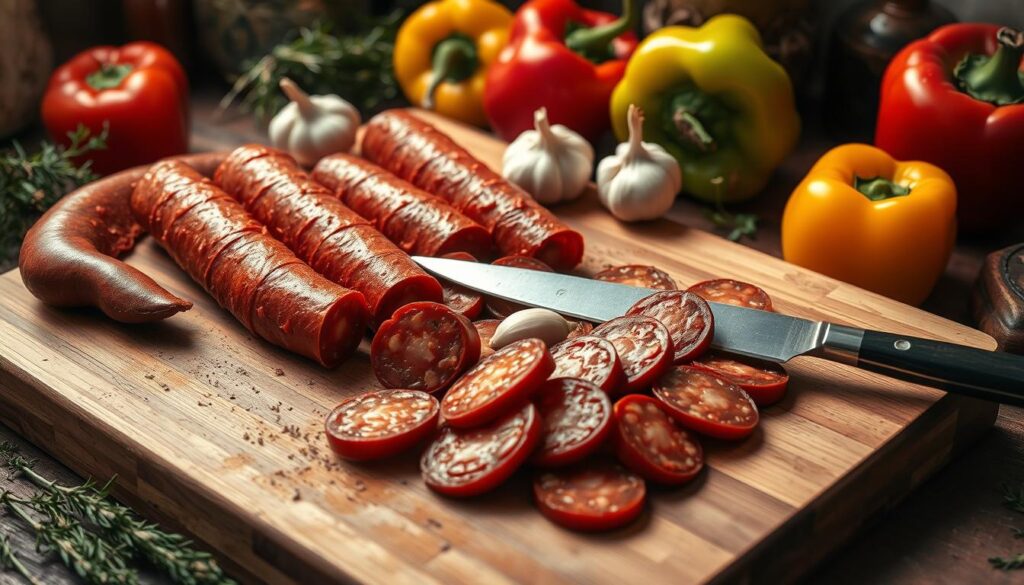
Does Spanish chorizo need to be cooked?
Introduction:
Wondering if Spanish chorizo needs to be cooked? This flavorful cured meat is a staple in many dishes, and understanding whether it requires cooking is essential for enjoying it properly. In this guide, you’ll learn all about Spanish chorizo, its preparation methods, and how to incorporate it into your favorite recipes.”
The first time I tried Spanish chorizo in a tapas bar, I was hooked by its smell and color. Many of us wonder if it needs to be cooked. This curiosity led me on a tasty journey I’m eager to share.
Spanish chorizo is more than just food; it’s a cultural gem. It can be tricky to figure out how to use it safely. This guide will help you understand if Spanish chorizo needs to be cooked. It will make you more confident in your cooking.
Key Takeaways
- Not all Spanish chorizo requires cooking
- Cured and fresh chorizo have different preparation methods
- Understanding chorizo types is crucial for safe consumption
- Proper storage extends chorizo’s shelf life
- Cooking methods can enhance chorizo’s flavor profile
Understanding Spanish Chorizo
Spanish cuisine is known for its cured meats, and chorizo is a standout. This sausage is loved for its bold flavors and versatility.

Spanish Chorizo Traditional Preparation
Exploring Spanish chorizo opens up a world of flavors. It’s more than just sausage; it’s a cultural tradition. It turns simple ingredients into amazing dishes.
What Is Spanish Chorizo?
Spanish chorizo is a special type of sausage from the Iberian Peninsula. It’s made with care, using:
- Coarsely chopped pork meat
- Distinctive red paprika (pimentón)
- Garlic and other traditional spices
Types of Spanish Chorizo
Spanish chorizo comes in many varieties, each with its own flavor. Here are the main types:
- Soft Chorizo (Chorizo Fresco): Fresh sausage that needs to be cooked
- Cured Chorizo (Chorizo Curado): Ready-to-eat, dry-aged sausage
- Semi-Cured Chorizo: Partially dried with a strong flavor
Key Ingredients in Spanish Chorizo
“The secret of great chorizo lies in its ingredients and the passion of its makers.” – Spanish Culinary Tradition
The magic of Spanish chorizo is in its ingredients. Real chorizo has:
- High-quality pork meat
- Smoked paprika (gives it its red color)
- Garlic
- Salt
- Additional regional spices
Getting to know Spanish chorizo is like discovering a culinary masterpiece. It shows how simple ingredients can become a beloved Spanish dish.
The Cooking Process of Spanish Chorizo
Exploring Spanish sausage preparation is a journey of culinary art. Cooking chorizo turns this Spanish delicacy into a flavorful experience. It excites the taste buds.

Spanish Chorizo Cooking Process
To understand Spanish chorizo, you need to know its traditional making and cooking. It’s a mix of science and art, from raw ingredients to a tasty sausage.
How Chorizo Is Made
Making Spanish chorizo involves key steps:
- Selecting high-quality pork meat
- Grinding the meat to the perfect consistency
- Mixing with signature spices like paprika
- Stuffing into natural casings
- Curing or smoking the sausage
Does Cooking Affect the Flavor?
Cooking changes chorizo’s flavor a lot. The doneness of chorizo is key to its smoky taste. Heat enhances the paprika notes and caramelizes the fats, making it taste intense.
“Cooking is about coaxing out the hidden flavors of great ingredients” – Spanish Culinary Tradition
Popular Cooking Methods
You can cook Spanish chorizo in several ways:
- Sautéing in a hot skillet
- Grilling for a smoky char
- Baking in casseroles
- Slow-cooking in stews
Each method highlights different qualities of the Spanish sausage. You can try different ways to find your favorite.
Do You Need to Cook Spanish Chorizo?
Understanding Spanish chorizo is key for safe and tasty meals. Not all chorizos are the same. Whether you need to cook them depends on their type and how they’re made.

Spanish Chorizo Cooking Guide
There are two main types of Spanish chorizo: cured and fresh. The main difference is in how they’re processed and if they’re safe to eat right away.
Differences Between Raw and Cured Chorizo
Cured Spanish chorizo has its own special traits compared to fresh ones:
- Cured chorizo is safe to eat without cooking
- Fresh chorizo needs to be cooked well to avoid health risks
- The texture and taste of these two types are quite different
Safe Consumption Guidelines
Knowing how to prepare chorizo is important for safety:
- Cured chorizo can be sliced and eaten straight away
- Fresh chorizo must be cooked to 160°F to be safe
- Always check the packaging for cooking instructions
“Know your chorizo type before serving to ensure both delicious and safe eating experiences.”
Common Misconceptions
Many people get confused about how to prepare chorizo. It’s important to know the difference between cured and fresh chorizo. Cured chorizo is safe to eat because it’s fermented and dried. But fresh chorizo needs to be cooked.
Always check your chorizo and follow the recommended cooking methods. This way, you can enjoy this tasty sausage safely.
Culinary Uses for Spanish Chorizo
Spanish cuisine is known for its rich flavors, and chorizo is a key ingredient. It makes simple dishes into something special. Knowing how to use it is key to great charcuterie.
Spanish chorizo opens up a world of tasty possibilities. Whether you cook at home or professionally, it can take your dishes to the next level.
Dishes That Feature Chorizo
Spanish chorizo is a star in many dishes:
- Paella Valencia
- Fabada Asturiana (bean stew)
- Spanish tortilla
- Cocido Madrileño (Madrid-style stew)
- Scrambled eggs with chorizo
Pairing Suggestions for Chorizo
Get the most out of cured meats by pairing chorizo with the right flavors:
| Ingredient | Pairing Recommendation |
|---|---|
| Cheese | Manchego, aged Gouda |
| Vegetables | Roasted peppers, potatoes |
| Wines | Tempranillo, Rioja |
How to Store Chorizo Properly
Keep your chorizo fresh by storing it right:
- Store cured chorizo in a cool, dry place
- Refrigerate after opening
- Wrap in wax paper or butcher paper
- Consume within 3-4 weeks
“Great cooking starts with understanding your ingredients” – Spanish Culinary Experts
Remember, each slice of Spanish chorizo tells a story of Spanish cuisine. Your culinary journey is just beginning!
Health Benefits of Spanish Chorizo
Spanish chorizo has a complex nutritional profile. It can be part of a balanced diet if eaten mindfully. Knowing how to safely prepare Spanish sausage helps you make better food choices.
Nutritional Value Breakdown
Spanish chorizo is packed with protein and has rich flavors. It offers several key nutrients. Let’s look at its nutritional composition:
- High-quality protein source
- Contains essential vitamins like B12
- Provides minerals such as zinc and selenium
| Nutrient | Amount per 100g |
|---|---|
| Protein | 24g |
| Fat | 32g |
| Calories | 455 |
Potential Risks When Consuming Chorizo
Spanish sausage is tasty but needs careful handling. Chorizo safety means knowing about health risks:
- High saturated fat content
- Sodium levels can be significant
- Potential preservatives in processed varieties
“Enjoy chorizo in moderation as part of a balanced diet” – Nutrition Experts
Moderation and Balance in Your Diet
To include chorizo in your meals, plan carefully. Portion control and pairing with nutrient-dense foods can lessen nutritional drawbacks.
- Limit weekly consumption
- Choose lean, high-quality chorizo
- Balance with vegetables and whole grains
Cooking Techniques for Chorizo
Cooking Spanish chorizo needs skill and knowing its special traits. Whether you cook at home or love cooking, the right methods can make your chorizo dishes amazing.
Sautéing vs. Grilling Chorizo
There are two main ways to cook chorizo: sautéing and grilling. Each method has its own benefits for cooking chorizo just right:
- Sautéing lets you control the heat for even cooking
- Grilling adds a smoky taste, typical of Spanish food
- Both ways help release the chorizo’s rich oils
Incorporating Chorizo into Recipes
Cooking chorizo is more than just prep—it’s about making dishes to remember. You can add this tasty sausage to many recipes, from breakfast scrambles to big paellas.
*”The secret to great chorizo is understanding its versatility in Spanish cooking.”*
Tips for Perfectly Cooking Chorizo
To get chorizo cooked just right, follow these expert tips:
- Take off the casing before cooking cured chorizo
- Use medium-low heat to avoid burning
- Cook until the edges get crispy and slightly caramelized
Learning these techniques will boost your Spanish cooking skills. It will also bring real flavors to your kitchen.
Spanish Chorizo vs. Other Types of Chorizo
Exploring cured meats shows us how different chorizos are. Spanish sausage making is special, with each area adding its own flavor.
Chorizo isn’t just one type. Each region has its own way of making these tasty sausages.
Spanish vs. Mexican Chorizo: Key Differences
- Spanish chorizo is a cured meat that you can eat raw
- Mexican chorizo needs to be cooked well before eating
- The texture of these sausages is quite different
Flavor Profiles Across Chorizo Types
| Chorizo Type | Primary Flavor Characteristics | Typical Ingredients |
|---|---|---|
| Spanish Chorizo | Smoky, rich, with paprika notes | Pork, paprika, garlic |
| Mexican Chorizo | Spicy, vibrant, with chili flavors | Pork, chili peppers, vinegar |
| Portuguese Chorizo | Wine-infused, slightly milder | Pork, red wine, garlic |
“The magic of chorizo lies in its regional diversity and rich culinary heritage.” – Spanish Culinary Experts
Knowing the differences between chorizos helps you enjoy them more. Whether you’re making traditional Spanish dishes or trying new recipes, understanding each type’s unique qualities will make your cooking better.
Purchasing Spanish Chorizo
Exploring Spanish cuisine is exciting, especially when looking for authentic chorizo. Knowing about charcuterie handling and the differences between cured and fresh chorizo helps you make better choices.
Where to Find Quality Chorizo
Searching for top-notch Spanish chorizo can lead you to many places:
- Specialty food stores
- Gourmet delicatessens
- Online specialty retailers
- Farmers markets
- Hispanic grocery stores
Identifying Authentic Spanish Chorizo
Finding real Spanish chorizo needs careful attention to a few key points:
- Look for Denominación de Origen certification
- Check the ingredient list for traditional spices like paprika
- Examine the color and texture
- Verify the production region in Spain
Price Ranges for Different Varieties
Chorizo prices change based on quality and origin. Here’s a detailed pricing guide:
| Chorizo Type | Price Range | Quality Indicator |
|---|---|---|
| Mass-produced | $5-$10 | Standard quality |
| Artisanal | $10-$25 | Premium ingredients |
| Iberian Heritage | $25-$50 | Highest quality |
“Authentic Spanish chorizo is not just a sausage, it’s a culinary experience.” – Spanish Cuisine Expert
By following these guidelines, you’ll become a confident chorizo connoisseur. You’ll be ready to dive into the rich flavors of Spanish charcuterie.
Popular Recipes Featuring Chorizo
Spanish cuisine is full of tasty recipes that highlight chorizo’s rich flavors. This versatile sausage brings excitement to many dishes, from old favorites to new creations.
Traditional Spanish Dishes with Chorizo
Discover the real taste of Spanish sausage through classic recipes loved by many:
- Paella Valenciana: A famous rice dish with chunks of chorizo
- Fabada Asturiana: A rich bean stew with chorizo and other meats
- Cocido Madrileño: A traditional chickpea and chorizo stew
Modern Takes on Chorizo Recipes
Today’s chefs are making Spanish cuisine fresh by adding chorizo to new dishes:
| Recipe | Fusion Style | Flavor Profile |
|---|---|---|
| Chorizo Mac and Cheese | American-Spanish Fusion | Spicy and Creamy |
| Chorizo Stuffed Peppers | Mediterranean Twist | Robust and Savory |
| Chorizo Pizza | Italian-Spanish Blend | Smoky and Rich |
Quick and Easy Chorizo Meals
For those short on time, these quick recipes bring Spanish taste to your table fast:
- Chorizo and Egg Breakfast Scramble
- 15-Minute Chorizo Pasta
- Instant Chorizo Tapas Platter
“Chorizo turns simple meals into amazing dishes!” – Chef Miguel Rodriguez
Frequently Asked Questions About Chorizo
Exploring Spanish chorizo can be a bit confusing. Many people wonder about its safety and how to prepare it. Let’s look at some common questions about chorizo.
Can You Eat Chorizo Raw?
It depends on the chorizo type. Cured meats like Spanish chorizo are usually safe to eat raw. They go through a preservation process that makes them ready to eat. There are two main types of chorizo:
- Cured (dry) chorizo: Can be eaten without cooking
- Fresh chorizo: Must be fully cooked before consumption
How Long Does Cooked Chorizo Last?
Keeping chorizo fresh is key. Here’s how to store cooked chorizo:
| Storage Location | Shelf Life |
|---|---|
| Refrigerator | 3-4 days |
| Freezer | 2-3 months |
Is All Chorizo Spicy?
Not all chorizo is spicy. Does Spanish chorizo need to be cooked? Most Spanish chorizos have a mild to moderate spice. But, the spice level can change a lot based on the recipe and region.
“Chorizo is like a flavor adventure – each bite tells a different story of Spanish culinary tradition.”
Pro tip: Always check the ingredient list or ask your butcher about the spice level. Some chorizos are mild, while others are quite spicy.
Serving Suggestions for Spanish Chorizo
Spanish cuisine is full of ways to enjoy cured meats, with chorizo being a top choice. Learning how to handle charcuterie can make your meals more exciting. It can turn simple dishes into something special.
There are many creative ways to serve Spanish chorizo. Its rich, smoky taste is perfect for many dishes and appetizers.
Classic Pairings for Chorizo
- Crusty Spanish bread
- Manchego cheese
- Roasted red peppers
- Olives from Mediterranean regions
Creative Serving Ideas
Make your charcuterie board stand out by arranging chorizo slices carefully. Try rolling thin chorizo strips around pickled vegetables or adding them to tapas platters.
Accompaniments That Enhance Flavor
- Drizzle high-quality olive oil
- Sprinkle smoked paprika
- Pair with robust red wines
- Add fresh herbs like parsley or thyme
“Great chorizo transforms ordinary meals into extraordinary experiences.” – Spanish Culinary Expert
The secret to serving Spanish chorizo well is to understand its flavor. Then, try different ingredients that bring out its best.
Final Thoughts on Cooking Spanish Chorizo
Your journey into Spanish chorizo has shown its delicious complexity. Whether you’re new to cooking chorizo or improving your skills, you’ve learned something important. The key is knowing how to cook it, based on its type and how it’s prepared.
Recap of Key Points
Exploring Spanish chorizo has uncovered its rich history. You now know the differences between cured and raw types. You also know how to cook it, making your dishes more flavorful.
Your Chorizo Cooking Journey
Trying out Spanish chorizo opens up many culinary doors. You’re now ready to choose, prepare, and use this sausage in many dishes. It can make any meal special with its smoky and spicy taste.
Encouragement to Experiment with Chorizo
Don’t be afraid to try new cooking methods and recipes. Every time you cook with Spanish chorizo, you discover new tastes. Trust yourself, be creative, and let your taste buds lead you in this exciting journey.
